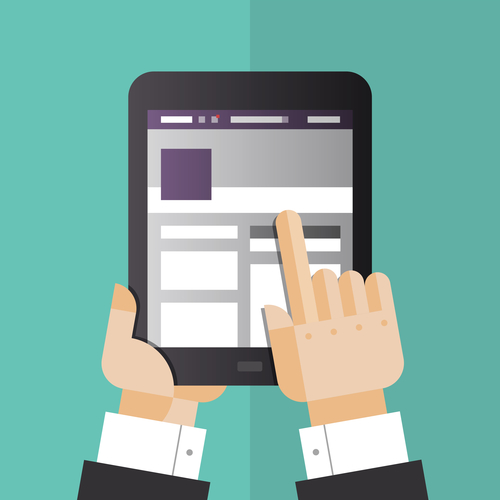In August 2016, Facebook rolled out its revamped business pages across desktop platforms. The new pages arrived as somewhat of a surprise for many business owners who were forced to learn new functionalities to optimize their pages — and updates continue to appear every few weeks.
Though the re-formatted business pages created some disgruntled business owners, the new layout was more appealing for the consumer. From white space that’s easier on the eyes to tighter organization and more attractive CTAs, the new format is an improvement.
So what do you need to know about Facebook’s new layout of its desktop business pages? A lot — some things are positive, some negative.
Facebook Business Pages: The Basics
FB business pages now feature three vertical columns and appear more like a traditional desktop website. The left-side navigation is replaced with tabs that can be customized for your business’s messages, and the cover photo is now less cluttered, standing alone at a larger 828 pixels wide x 315 pixels tall.
Though appealing on desktop, where most businesses typically work from daily, 133 pixels on either side are missing from mobile. Why? The remaining 563 pixels match the middle column of posts, which makes it smooth looking on mobile.
The cover photo stands completely alone, and there’s no overlapping of the profile picture, now called “logo image,” or the “Like” button.
Below the picture are four buttons: Like, Follow, Share, and More. Many business admins are still confused about the differences between “Like” and “Follow”. If a visitor likes your page, they will be set to automatically follow it. Like simply means they are part of your audience, but Follow means they will see your posts. If a person decides to stop following but continues to like, they won’t see your posts but will continue to be part of your audience.
There are two types of following available: Default or See First. The latter is the following a business wants because that business’s post feed will always show up on the visitor’s page.
Here’s a quick recap:
- Not Liked, Not Following: Zero engagement
- Liked, Not Following: User will show up as part of your audience, but won’t see any of your posts. These are the ones you want to persuade to not only follow, but See First follow (more below).
- Liked, Default Following: This is what occurs when someone likes your page. Facebook’s machine learning algorithm (formerly what EdgeRank used to do) will then determine how often the user sees your page. Better, but still not the best.
- Liked, See First Following: This is the ideal situation, and you want to persuade your audience to do this. This will prioritize your posts in the user’s feed, and supersedes the machine learning algorithm.
Under the Following tab, users can also choose if they want to be notified about Live Videos.
 The profile picture, now called logo image, was moved to the left of the cover photo, and is a 160-pixel square. Underneath this logo image is the page name, along with the page username that now features a Twitter-esque @ before the title.
The profile picture, now called logo image, was moved to the left of the cover photo, and is a 160-pixel square. Underneath this logo image is the page name, along with the page username that now features a Twitter-esque @ before the title.
For true optimization, try to change either your Facebook or Twitter name to match each other now that the @ is in play in Facebook pages. This is a PITA due to the administrative process at each organization, but it’ll keep branding closely associated — just as you should use the same profile, um, Facebook logo image, among all social media profiles.
The username is followed by a left-side tabs list. Gone is the left-side sections of photos and videos, etc., and in its place are tabs. Ten tabs are available: About, Posts, Photos, Reviews, Likes, Videos, Shop, Events, Services, and Notes.
Each tab has settings that allow the insertion of a URL, and can either be visible or hidden from visitors. You can also reorder them, which is helpful to highlight what’s most important for your visitors to see first.
All sections are now moved to the right column. They are customizable and feature content like business info, ratings, about, followers/likes, photos, and visitor posts. The most innovative feature on the right is “Search for posts on this Page,” which allows visitors to do just that. This is great for users to find something specific, or for businesses to do competitor research when looking for content.
Also, the new layout doesn’t feature any right-side ads. This may sound like a dumb move on Facebook’s part, but 2016 Q3 results show that 84% of its revenue arrives from mobile ads.
Facebook Business Pages: In-Your-Face CTA
By far the most appealing part of the new layout is the huge Call-to-Action button. The CTA used to be on the cover photo, but is now cleaner and more noticeable. You can choose from five main options with various CTA messages:
- Book Our Services (Book Now, Start Order)
- Get in Touch with Us (Call Now, Contact Us, Send Message, Sign Up, Send Email)
- Learn More About Us (Watch Video, Learn More)
- Make a Purchase or Donation (Shop Now)
- Use our App or Game (Use App, Play Game)
Plus, for each option, there are “Partner Apps and Services” to customize the CTA such as Delivery.com and TalkLocal. Each CTA is self-explanatory, and is easy to switch based on your marketing needs at any given time.
Facebook Business Pages: Post Options
The newest revision that launched the second week of January are “post options” that allows nine different options for enhancing a post:
- Share a photo or video
- Get sign-ups
- Advertise your business
- Get phone calls
- Get messages
- Help people find your business
- Create an event
- Create an offer
- Write a note
Now businesses can experiment with each one, and social media managers should take the time to make this practice regular. Sharing short marketing messages with a photo or video was always the optimal tactic, but now businesses can build an entire long-term strategy around these nine post options based on offers or trending services.
Facebook Business Pages: Confusion Between Page Roles
Yes, the new layout works for most, but it has its quirks regarding page roles that business owners must realize. When using a personal page on the previous pages version, Admins or Editors would simply visit their business page on desktop or mobile and post with necessary tags of others included in the post.
But now, these roles create different needs for posting. Page Editors have it simple: They can visit their business’s page from their personal page and simply post like the previous version. The nine different post options are also present, and tagging is possible. The middle box of statistics (posts reached, website clicks, etc.) that’s inline with posts is also present.
But it’s not so easy for Admins. When they visit their business’s Facebook page from their personal page, they are viewing it as an outsider. If it’s just a quick post that’s needed, they now must switch “posting as” to the business, and post. But for Admins, tagging and the nine different post options are not available, and neither is the box of statistics. You also can’t “manage tabs,” though the tab is there.
The solution for desktop is to scroll to the top and choose “Go to Business Manager to manage this Page.” For mobile, it’s simply a matter of using the Pages app, which most business posters do anyway.
Concluding Thoughts
The new layout of Facebook pages is still bugging many, but the simplest solution is to spend an hour playing with the new features. The most important features are highlighted above, but in typical Facebook development fashion, more will continue to develop. Just remember, once you have this layout mastered, it may suddenly change. You can always expect the unexpected with Facebook.
Images via DepositPhotos.




